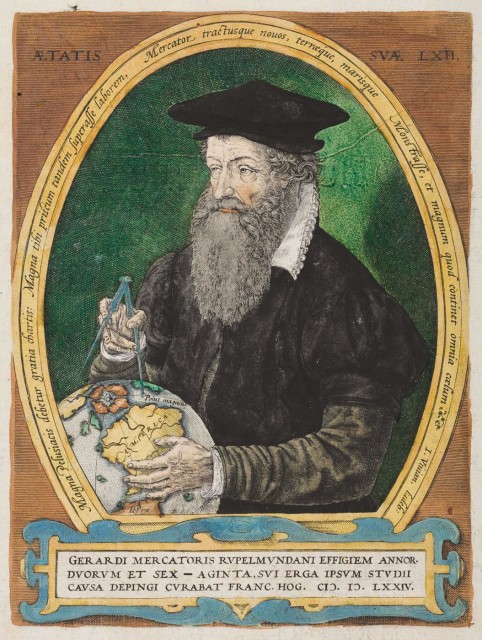Mercator, Gerardus (1512–1594)
GERARDUS MERCATOR is the Latin name of Gerhard Kremer, one of the greatest geographers and cartographers, who lived in the 16th century. He was born on March 5, 1512, in Rupelmonde in the Flanders (now in BELGIUM), seventh child of Hubert and Emerentia Kremer. His father was a shoemaker. Thanks to his paternal uncle Gisbert Kremer, he went to Bois le Duc for two years to study philosophy and mathematics at Lovanio University, where he graduated as magister.
He studied under the guidance of mathematician Gemma Frisius and instrument maker Gaspar van der Heyden (Gaspar a Myrica). Mercator devoted himself to making mathematical instruments, such as astrolabes and armillary spheres, and to the art of the copperplate engraving, soon becoming so famous he received orders from the emperor, Charles V.

In 1534, he opened a house of cartographic production, and in 1537 he printed his first work, the map of Palestine Amplissima Terrae Sanctae descriptio ad utriusque testamenti intelligentiam, in six sheets. In 1538 he printed his map of the world and in 1540 the map of Flanders in four sheets. In 1540, his work Literarum latinarum quas italicas cursoriasque vocant scribendi ratio was printed, written to uniform the toponymy and to use Latin handwriting on maps.
In 1544, in a moment of religious conflict during the Lutheran Reformation, Mercator was imprisoned under suspicion of heresy, but he was released in a short time thanks to the help of some very eminent people. In 1552, he moved to Duisburg (GERMANY), where in 1554 he printed his map of Europe in 15 sheets that had a second edition in 1572. Mercator was appointed court cartographer by Duke Wilhelm of Cleve in 1564. During this year, the map Angliae Scotiae et Hiberniae nova descriptio was printed and in 1569 the great map of the world, Nova et aucta orbis terrae descriptio, in 18 sheets, was issued to help in navigation.
Thanks to this work, Mercator is heralded as the founder of modern cartography as a science, founding it on the mathematical method and not on the artistic empiricism prevalent at his time. He, for the first time, used a new way to draft maps with isogonic projection, today called the Mercator projection (1556). For the map to conserve the angles and the representation of the loxodromic curve with a straight line, Mercator's projection is used today also to draft navigation charts. On a globe, the lines of longitude (measuring east-west position) converge at the poles and the lines of latitudes (measuring north-south position) are at equal distance. In a Mercator projection, the lines of longitude are straight vertical lines at equal distance at all latitudes, and horizontal distances are stretched above and below the equator: this alteration is excessive near the poles. The Mercator projection mathematically stretches vertically distances from the same proportion as the horizontal distances so that shape and direction are conserved.
Mercator wished to compile a great encyclopedic work containing the entire geographical knowledge of the universe and the history of geographical science, but so great project was impossible to realize by one person only, and it remained unfinished. He started publishing the Chronologia (1569) and finally the Atlas, sive cosmographicae meditationes de fabrica mundi et fabricate figura (1585–95), republished complete only posthumously in 1602 by his heirs. This work is composed of a first part, Galliae, Belgii Inferioris, Germaniae tabulae geographicae, containing 51 maps, and a second part, with 29 maps, edited posthumously by his son Rumold. The Atlas of Mercator had in the following years several editions, the great part abridged. He was also the first to use the term atlas for a collection of maps.
Mercator also made an earth globe (1541) and a celestial globe (1551) with great success and built numerous duplicates. He was also the author of the philosophical work De mundi creatione ac fabrica liber, written when he was still young but published only in 1592, Evangelicae historiae quadripartite Monas, sive Harmonia quatuor evangelistarum, to defend his Chronologia from the accusation of being mistaken about the birth year of Christ. On May 5, 1590, Mercator had a massive stroke that left his left side paralyzed. Frustrated since he could no longer work, he slowly recovered but suffered from his inability to continue his map making projects. By 1592, he was able to do a small quantity of work again, but he was almost blind. He had a second stroke at the end of 1593, which took away his ability to speak, and although he tried hard, regaining some speaking capability, a third stroke was fatal to him. Mercator died on December 2, 1594, in Duisburg.
The works of Mercator are regarded as the product of the synthesis of the Renaissance culture, critically reconstructing the text and maps of the past, and imposing a new scientific way to compile maps.